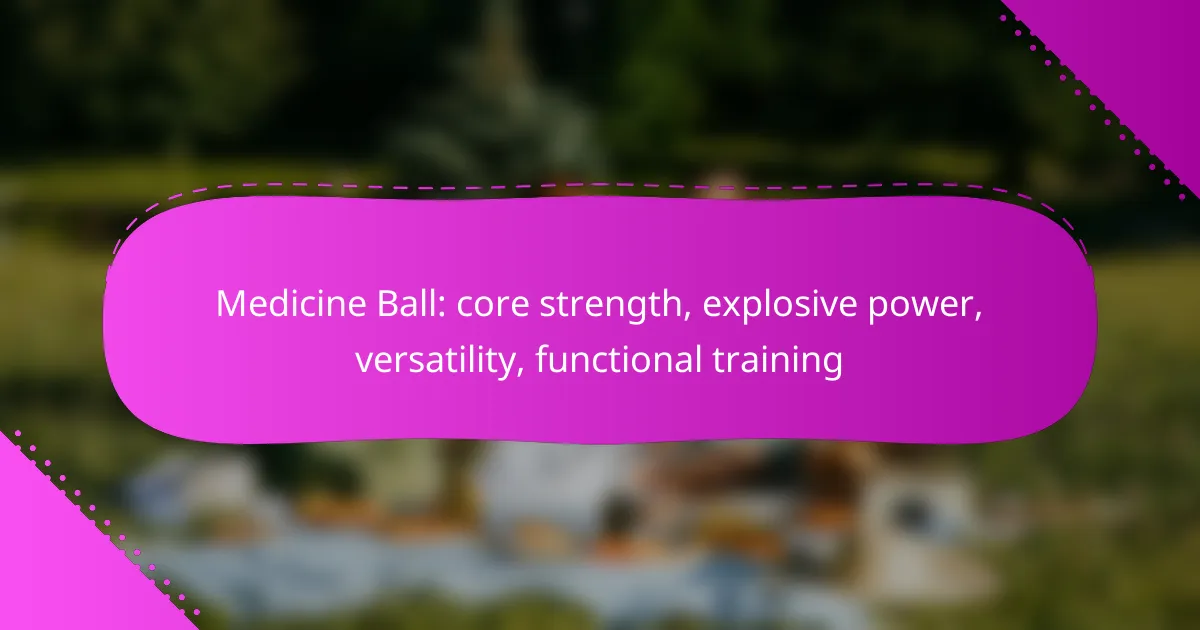Medicine balls are essential tools for enhancing core strength and developing explosive power through dynamic movements. Their versatility allows for a wide range of exercises that target multiple muscle groups, making them ideal for both athletes and fitness enthusiasts. When choosing a medicine ball for functional training, it’s important to consider factors such as weight, surface material, and diameter to maximize your workout effectiveness.

How can medicine balls improve core strength?
Medicine balls enhance core strength by engaging the abdominal muscles and stabilizers during dynamic movements. Their weight and versatility allow for a variety of exercises that challenge the core in different planes of motion.
Stability and balance enhancement
Using a medicine ball requires maintaining stability while performing exercises, which directly improves balance. Movements like medicine ball slams or rotational throws force the core to engage and stabilize the body, enhancing overall stability.
Incorporating exercises that involve balance, such as standing on one leg while performing a medicine ball pass, can further challenge the core and improve proprioception. This can be particularly beneficial for athletes or individuals looking to enhance their functional fitness.
Engagement of multiple muscle groups
Medicine ball workouts often involve compound movements that activate various muscle groups simultaneously. For example, a medicine ball squat throw engages the legs, core, and shoulders, providing a full-body workout.
By incorporating different muscle groups, these exercises not only build core strength but also improve overall athletic performance. This multi-muscle engagement can be particularly effective for those training for sports or functional activities.
Increased abdominal activation
Exercises with medicine balls significantly increase abdominal activation compared to traditional exercises. Movements such as Russian twists or overhead throws require the core to engage dynamically, leading to greater muscle recruitment.
To maximize abdominal activation, focus on controlled movements and proper form. Avoid using momentum; instead, emphasize slow, deliberate actions to ensure the core is fully engaged throughout the exercise.

What are the best medicine ball exercises for explosive power?
Medicine ball exercises that enhance explosive power include dynamic movements that engage multiple muscle groups. These exercises improve strength, speed, and coordination, making them effective for athletes and fitness enthusiasts alike.
Medicine ball slams
Medicine ball slams are a high-intensity exercise that targets the core, shoulders, and legs. To perform a slam, start in a standing position, lift the ball overhead, and forcefully slam it down to the ground while engaging your core. This explosive movement not only builds power but also enhances coordination and cardiovascular endurance.
When executing slams, focus on maintaining a strong posture and using your legs to generate force. Aim for 10-15 repetitions per set, adjusting the weight of the ball based on your fitness level. Common pitfalls include using too much upper body strength instead of engaging the core and legs.
Chest passes
Chest passes involve throwing the medicine ball from the chest level to a partner or wall, emphasizing upper body strength and explosive power. Stand with your feet shoulder-width apart, hold the ball at chest height, and push it forward explosively while stepping into the throw. This movement mimics actions in various sports, enhancing functional strength.
For effective training, perform 8-12 repetitions per set, ensuring to use a weight that challenges you without compromising form. Avoid leaning back during the throw, as this can lead to injury. Practicing with a partner can also improve accuracy and timing.
Overhead throws
Overhead throws are another excellent exercise for developing explosive power, targeting the shoulders, core, and legs. To execute this movement, lift the medicine ball overhead and throw it backward or forward, depending on your training focus. This exercise simulates movements used in sports like basketball and football.
Incorporate 6-10 overhead throws per set, using a weight that allows for explosive movement without sacrificing control. Be cautious of your lower back; engage your core throughout the motion to prevent strain. Practicing with a lighter ball can help improve technique before progressing to heavier weights.

Which medicine ball features should I consider for functional training?
When selecting a medicine ball for functional training, consider weight, surface material, and diameter for optimal performance. These features influence your workout effectiveness and comfort during exercises.
Weight options
Medicine balls come in various weights, typically ranging from 1 kg to 10 kg or more. Choosing the right weight is crucial for functional training; lighter balls are ideal for beginners or rehabilitation, while heavier options are better for advanced strength training.
As a general guideline, select a weight that allows you to perform 8-12 repetitions of an exercise with good form. If you can easily complete more than 12 reps, consider increasing the weight.
Surface material
The surface material of a medicine ball affects grip and durability. Common materials include rubber, vinyl, and leather, each offering different levels of traction and comfort. Rubber balls are often more durable and suitable for outdoor use, while vinyl options may provide a softer feel for indoor workouts.
For functional training, choose a material that suits your workout environment and personal preference. If you plan to use the ball for high-impact exercises, opt for a more robust material to withstand wear and tear.
Diameter and grip
The diameter of a medicine ball can impact how comfortably you can hold and control it during exercises. Most medicine balls have a diameter ranging from 25 cm to 35 cm. A larger diameter may be more challenging to grip, especially during dynamic movements.
When selecting a ball, consider your hand size and the types of exercises you plan to perform. Ensure the grip feels secure and comfortable, as this will enhance your performance and reduce the risk of injury during functional training.

How do I choose the right medicine ball for my workouts?
Choosing the right medicine ball involves considering your skill level, training goals, and the specific features of the ball. Look for a weight and size that matches your fitness level and the exercises you plan to perform.
Skill level assessment
Your skill level is crucial in selecting a medicine ball. Beginners should start with lighter weights, typically ranging from 2 to 4 kg, to master form and technique. Intermediate and advanced users can opt for heavier balls, usually between 4 to 10 kg, depending on their strength and experience.
Assess your current fitness level by evaluating your ability to perform exercises like squats, throws, and twists. If you struggle with basic movements, it’s wise to choose a lighter ball until you build confidence and strength.
Training goals alignment
Your training goals should guide your choice of medicine ball. If you’re focusing on core strength, a ball with a textured surface can enhance grip during dynamic movements. For explosive power, consider a heavier ball that challenges your muscles during throws and slams.
Align the ball’s weight with your specific objectives. For example, if your goal is to improve athletic performance, a ball weighing around 6 to 8 kg is often effective for high-intensity workouts.
Recommended brands in Australia
Several reputable brands offer quality medicine balls in Australia. Brands like Dynamax, ProForm, and Everlast are popular for their durable construction and varied weight options. These brands provide a range of sizes and weights, making it easier to find a suitable ball for your needs.
When purchasing, consider local retailers or online platforms that specialize in fitness equipment. Ensure the ball you choose has good reviews regarding durability and performance to make a worthwhile investment.

What are the benefits of using medicine balls in workouts?
Medicine balls offer numerous benefits in workouts, including improved core strength, explosive power, and versatility in training. They can be incorporated into various exercises to enhance functional fitness and overall athletic performance.
Versatility in training
Medicine balls are incredibly versatile and can be used for a wide range of exercises targeting different muscle groups. They can be integrated into strength training, cardio workouts, and even rehabilitation programs. This adaptability makes them suitable for individuals of all fitness levels.
Common exercises include wall throws, slams, and rotational movements, which can be performed alone or in groups. The ability to adjust the weight of the ball allows users to progressively challenge themselves, making it easy to tailor workouts to specific goals.
Improved coordination
Using medicine balls can significantly enhance coordination and balance. Many exercises require simultaneous movement of multiple body parts, promoting better neuromuscular control. This is particularly beneficial for athletes looking to improve their performance in sports that demand agility and precision.
Incorporating medicine ball drills into your routine can help develop hand-eye coordination and overall body awareness. For instance, practicing throws and catches with a partner can refine timing and spatial awareness, essential skills in many physical activities.
Enhanced metabolic rate
Medicine ball workouts can elevate your metabolic rate, leading to increased calorie burn both during and after exercise. The combination of strength and explosive movements engages multiple muscle groups, resulting in a higher energy expenditure compared to traditional workouts.
To maximize this effect, consider incorporating high-intensity interval training (HIIT) with medicine balls. Short bursts of intense activity followed by brief rest periods can effectively boost metabolism and improve cardiovascular fitness, making it a time-efficient training option.

How do medicine balls compare to other training tools?
Medicine balls offer unique benefits in strength training, particularly in developing core strength and explosive power. Compared to other tools, they provide versatility in functional training, allowing for a wide range of exercises that engage multiple muscle groups.
Versus kettlebells
Medicine balls and kettlebells serve different purposes in strength training. While kettlebells are excellent for building strength and improving grip, medicine balls excel in enhancing core stability and explosive movements. This makes medicine balls particularly suitable for dynamic exercises like slams and throws.
When considering which tool to use, think about your training goals. If your focus is on power and agility, medicine balls can be more effective. However, if you aim to build overall strength and endurance, incorporating kettlebells into your routine may be beneficial.
To maximize your training, combine both tools. For example, use kettlebells for strength-focused workouts and medicine balls for explosive, functional movements. This approach can lead to a well-rounded fitness regimen that targets various aspects of physical performance.
